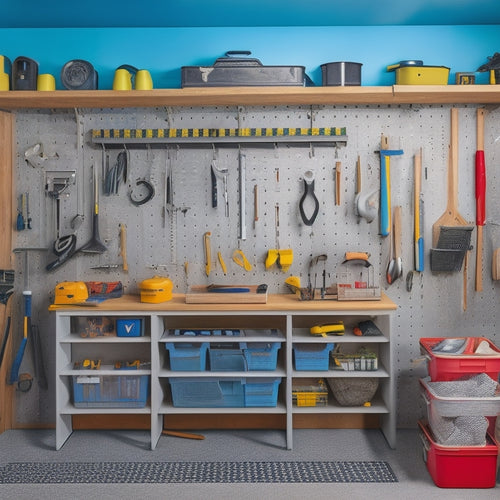
7 Essential Layout Strategies for Entrepreneurial Success
Share
You're already running a business, which means you're likely no stranger to the importance of optimizing your workspace for maximum efficiency and productivity - and a well-designed layout is the key to opening it up. To get you started, focus on maximizing floor space efficiency, optimizing tool accessibility flow, and streamlining production workflow paths. Implement zone-based organization, designate task-specific stations, and prioritize ergonomic workspaces to boost productivity. Finally, adapt your layout to meet scalable growth needs. By incorporating these seven essential layout strategies, you'll be well on your way to achieving entrepreneurial success - and there's even more to discover.
Key Takeaways
• Strategically design your workspace to minimize waste, maximize functionality, and reduce congestion for improved workflow and organization efficiency.
• Ensure easy access to frequently used tools by organizing them logically, using clear labels, and developing a mental map of your workspace.
• Streamline production workflow paths by prioritizing tasks, eliminating unnecessary steps, and using time-blocking to maximize productivity and identify bottlenecks.
• Divide your workspace into distinct areas and create productivity zones to focus on individual tasks, reduce interruptions, and increase overall productivity.
• Optimize task performance and boost station efficiency by dedicating specific areas to tasks, eliminating distractions, and investing in comfortable and ergonomic workspace design.
Maximize Floor Space Efficiency
To optimize your business's productivity and profitability, maximize your floor space efficiency by strategically designing your layout to minimize waste and maximize functionality. A well-planned layout enables you to make the most of your available space, reducing congestion and improving workflow. This, in turn, boosts organization efficiency and productivity optimization.
When designing your layout, consider the 'work zones' in your facility. Identify areas that require heavy foot traffic, such as production lines or storage areas, and allocate sufficient space to accommodate these activities. Implementing a logical workflow will streamline processes, reduce travel time, and increase overall productivity.
Effective space utilization also involves eliminating unnecessary obstacles, such as cluttered walkways or poorly placed equipment. By doing so, you can create a more organized and efficient work environment that supports your business goals.
Optimize Tool Accessibility Flow
As you design your workspace, you'll want to optimize tool accessibility flow to save time and increase productivity.
You can do this by streamlining navigation paths, simplifying workflow processes, and reducing click distances.
Streamline Navigation Paths
You can greatly enhance productivity by streamlining navigation paths, ensuring your most frequently used tools are easily accessible and organized in a logical flow. This means creating user-friendly interfaces with efficient layouts that allow you to quickly find what you need. By doing so, you'll reduce the time spent searching for tools, and increase the time spent on actual work.
To achieve this, focus on intuitive navigation that provides a seamless flow between tasks. Group similar tools together, and consider categorizing them based on frequency of use. This will help you develop a mental map of your workspace, allowing you to quickly locate the tools you need.
Additionally, consider the visual hierarchy of your layout, using clear labels, icons, and colors to draw attention to important elements. By streamlining your navigation paths, you'll be able to work more efficiently, and make the most of your time.
Simplify Workflow Processes
By organizing your tools in a logical flow, you've set the stage for simplifying your workflow processes, where every click and keystroke counts. Now, it's time to optimize your tool accessibility flow to maximize productivity.
To achieve this, focus on implementing digital automation and technology integration to streamline your workflow. This will enable you to make the most of your time and energy.
Here are some essential strategies to get you started:
-
Automate repetitive tasks: Identify tasks that can be automated, and use tools or software to take care of them. This will free up time for more critical tasks that require your attention.
-
Implement productivity hacks: Develop shortcuts and workflows that help you complete tasks efficiently. This could include using keyboard shortcuts or creating custom workflows within your tools.
-
Centralize your tools: Make certain that all your tools and resources are easily accessible from a central location. This will save you time and reduce the likelihood of switching between multiple apps or windows.
Reduce Click Distances
Optimizing tool accessibility flow begins with reducing click distances, allowing you to swiftly navigate your digital workspace and access essential tools in just a few clicks. This strategy is vital for creating user-friendly interfaces and efficient layouts that boost productivity. By minimizing the number of clicks needed to access critical tools, you'll save time and energy, freeing yourself to focus on high-priority tasks.
When designing your digital workspace, prioritize tools that require frequent use. Place them in easily accessible locations, such as the top navigation bar or a prominent dashboard. This will reduce the effort required to access essential features, allowing you to work more efficiently.
Additionally, group related tools together, making it easier to find what you need quickly. By streamlining your tool accessibility flow, you'll minimize user effort and increase productivity. This, in turn, will enable you to achieve more in less time, giving you a competitive edge in the entrepreneurial landscape.
Streamline Production Workflow Paths
As you work to streamline your production workflow paths, you'll want to focus on optimizing task sequencing to get the most out of your operation.
By identifying and addressing inefficiencies, you can eliminate bottlenecks that slow you down and cost you money.
Optimize Task Sequencing
You can greatly reduce production downtime and costs by identifying and rearranging tasks that can be performed concurrently or in a more logical order. By optimizing task sequencing, you can streamline your production workflow paths and achieve significant efficiency gains. This involves analyzing your workflow to identify tasks that can be performed simultaneously, and reordering them to minimize dependencies and maximize productivity.
Here are some key strategies to keep in mind:
-
Prioritize tasks based on urgency and importance: Focus on completing high-priority tasks first to make sure that critical deadlines are met.
-
Identify and eliminate unnecessary steps: Remove any tasks that don't add value to your workflow, and simplify processes where possible.
-
Use time-blocking to schedule tasks: Allocate specific time slots for each task to make sure that you're dedicating sufficient time and resources to each activity.
Eliminate Bottlenecks Efficiently
Frequently, bottlenecks in production workflows arise from inefficient task allocation, inadequate resource distribution, or poorly designed processes, and it's crucial to identify and eliminate these bottlenecks to maintain a smooth production flow.
You can't afford to let bottlenecks slow down your operations, or you'll risk losing valuable time, money, and resources.
To eliminate bottlenecks efficiently, start by identifying the root causes of the problem. Use data and analytics to pinpoint areas where your workflow is getting stuck. Then, re-allocate resources to tackle the bottleneck head-on. This might mean reassigning tasks, adding more personnel, or investing in new equipment.
Next, track efficiency metrics to make sure your changes are having the desired impact. Regularly review your workflow to pinpoint areas for process improvement.
Implement Zone-Based Organization
Divide your workspace into distinct areas, each dedicated to a specific task or activity, to maximize efficiency and minimize distractions. This zone-based organization strategy allows you to optimize your spatial arrangement, creating productivity zones that boost your workflow. By separating your workspace into functional areas, you can focus on individual tasks without interruptions, reducing the likelihood of mistakes and increasing overall productivity.
Here are some key benefits to ponder:
-
Reduced shift time: With dedicated areas, you can quickly switch between tasks without wasting time on setup or cleanup.
-
Improved focus: By separating tasks into distinct areas, you can eliminate distractions and maintain concentration on the task at hand.
-
Enhanced teamwork: Area-based organization enables you to designate spaces for team collaboration, promoting effective communication and idea-sharing.
Designate Task-Specific Stations
Designate Task-Specific Stations
By assigning specific tasks to designated stations, you'll be able to streamline your workflow, reduce handover time, and increase overall efficiency. This layout strategy allows you to optimize task performance and boost station efficiency. By dedicating a specific area to a particular task, you can eliminate distractions, minimize equipment clutter, and maximize productivity flow.
Here's a sample layout to get you started:
| Station | Task | Equipment |
|---|---|---|
| Station 1 | Order Fulfillment | Packing materials, shipping labels |
| Station 2 | Product Assembly | Assembly line tools, components |
| Station 3 | Quality Control | Inspection equipment, defect tracking software |
| Station 4 | Inventory Management | Inventory software, barcode scanner |
| Station 5 | Research and Development | Workbench, prototyping tools |
Prioritize Ergonomic Workspaces
By organizing your tasks into dedicated stations, you've taken a significant step towards streamlining your workflow; now, it's crucial to focus on creating workspaces that prioritize your physical well-being and comfort.
As an entrepreneur, you likely spend a significant amount of time at your desk, so it's vital to create an environment that promotes comfort and reduces the risk of injury.
Here are some key elements to bear in mind when prioritizing ergonomic workspaces:
-
Invest in comfortable seating: A good chair can make all the difference in reducing back and neck strain. Look for chairs with adjustable height and lumbar support.
-
Opt for adjustable desks: Desks that can be adapted to different heights allow you to switch between sitting and standing throughout the day, reducing the risk of fatigue and discomfort.
-
Incorporate natural lighting and greenery: Natural light can enhance your mood and energy levels, while plants can help purify the air and create a calming atmosphere.
Adapt to Scalable Growth Needs
As your business takes off, you'll need to adapt your workflow and operations to accommodate scalable growth, ensuring that your systems, processes, and team can handle increased demand without sacrificing efficiency or quality. This means integrating technology to streamline tasks, automate workflows, and enhance collaboration.
You'll also need to optimize space utilization, ensuring that your physical environment can accommodate growing teams and evolving needs.
Effective growth planning is essential to scalable success. Identify areas where your business can flex and adapt to changing demands, and design your operations with flexibility in mind. This might mean creating modular workspaces, investing in multi-functional equipment, or developing a scalable supply chain.
Frequently Asked Questions
How Often Should I Reassess My Layout for Optimal Efficiency?
"You'd want to reassess your layout daily if possible, but realistically, schedule regular evaluations every quarter to implement strategic adjustments, driving continuous improvement and maximizing efficiency, ensuring your operation runs like a well-oiled machine."
Can I Apply These Strategies to a Home-Based Business?
You can definitely apply these strategies to a home-based business, leveraging flexibility and adaptability to optimize your space. Assess your space utilization and ergonomics to create a productive and comfortable work environment that boosts efficiency.
What if My Production Process Involves Hazardous Materials?
When working with hazardous materials, you must prioritize safety above all. Develop and strictly follow safety protocols, implement proper hazardous material management, and guarantee compliance with regulations to minimize risks and prevent accidents.
Are There Any Layout Strategies for Businesses With Limited Budget?
You'll need creative solutions and cost-effective approaches to optimize your layout on a limited budget. Start by maximizing space and optimizing workflow to increase efficiency, then look for affordable materials and repurpose existing equipment to save costs.
How Do I Balance Employee Comfort With Productivity Goals?
"Did you know 70% of employees feel their workspace affects their well-being? You balance comfort and productivity by prioritizing ergonomic design, optimizing workflow, and creating spaces that support employee well-being, ultimately boosting overall performance."
Related Posts
-

Best Organizing Tools for a Clutter-Free Space
You're on a mission to change your cluttered space into a peaceful oasis, and you're looking for the best organizing ...
-

Advantages of a Pegboard System in Your Garage
You can instantly alter your garage into a more organized, efficient, and productive space by installing a pegboard s...
-

Heavy-Duty Commercial Rolling Shelving Racks
You need heavy-duty commercial rolling shelving racks that optimize your storage capacity, streamline operations, and...


